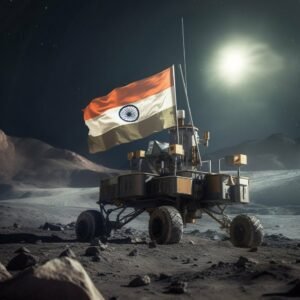Analyzing data obtained from India’s Chandrayaan-1 lunar mission, scientists have made a significant discovery claiming that high-energy electrons from the Earth may be forming water on the Moon.

The research team led by experts from the University of Hawai’i (UH) at Manoa in the United States discovered that these electrons in Earth’s plasma sheet contribute to weathering processes — breaking down or dissolving rocks and minerals — on the Moon’s surface.
The research, published in Nature Astronomy, found that the electrons may have aided water formation on the lunar body.
The researchers said that knowing the concentrations and distributions of water on the Moon is critical to understanding its formation and evolution and providing water resources for future human exploration.
The new finding may also help explain the origin of the water ice previously discovered in the permanently shaded regions of the Moon, they said.
Chandrayaan-1 played a crucial role in discovering water molecules on the Moon. The mission, launched in 2008, was the first Indian lunar probe under the Chandrayaan program.
The solar wind, composed of high-energy particles such as protons, bombards the lunar surface and is thought to be one of the primary ways water is formed on the Moon.
The team investigated the changes in surface weathering as the Moon passes through Earth’s magnetotail. This area almost wholly shields the lunar body from solar wind but not the Sun’s light photons.
“This provides a natural laboratory for studying lunar surface water formation processes,” said Shuai Li, an assistant researcher at the UH Manoa School of Ocean.
“When the Moon is outside the magnetotail, the lunar surface is bombarded with solar wind. There are almost no solar wind protons inside the magnetotail, and water formation was expected to drop to nearly zero,” Li said.
Li and co-authors analyzed the remote sensing data collected by the Moon Mineralogy Mapper instrument, an imaging spectrometer, onboard India’s Chandrayaan 1 mission between 2008 and 2009.
Specifically, they assessed the changes in water formation as the Moon traversed through Earth’s magnetotail, including the plasma sheet.
“To my surprise, the remote sensing observations showed that the water formation in Earth’s magnetotail is almost identical to when the Moon was outside the Earth’s magnetotail,” said Li.
“This indicates that, in the magnetotail, there may be additional formation processes or new water sources not directly associated with the implantation of solar wind protons. In particular, radiation by high energy electrons exhibits similar effects as the solar wind protons,” he explained.
The researchers added that this finding and the team’s previous study of rusty lunar poles indicate that the Earth is strongly tied to its Moon in many unrecognized aspects.
Chandrayaan 1 was launched by the Indian Space Research Organisation (ISRO) in October 2008 and operated until August 2009. The mission included an orbiter and an impactor.
India landed the Chandrayaan-3 mission, with a rover and a lander, near the Moon’s enigmatic south pole last month, becoming the first country to do so.









